

2 0 0 0
The Magazine of Peabody Demonstration School & University School of Nashville Winter 2020
We’d love to hear from you about anything you read in this edition of 2000 Edgehill and whatever you have to say about your student days here. Help PDS/USN and classmates keep up with what is happening in your personal and profes sional lives by kindly sending a Class Note by June 1, 2020.
n Social Media: Use #beyondEdgehill when sharing good news and PDS/USN memories.
n Email: Send a Letter to the Editor at Class Notes should go to attached at the highest resolution available.
n Mail: Write to Juanita I.C. Traughber
Communications Director
2000 Edgehill Ave. Nashville, TN 37212
Find 2000 Edgehill online at

This edition of 2000 Edgehill was published in March 2020 by the Communications Office and Alumni & Development Office for the Peabody Demonstration School and University School of Nashville community.
Vincent W. Durnan Jr. Director
Juanita I.C. Traughber Communications Director
Anne Westfall Development Director
Patti Wexler Alumni Director
Jenny Winston Archivist
Copy Editors
Juliet Douglas Lorie Strong
Anne Westfall
Jenny Winston
Photographer
Kimberly Manz
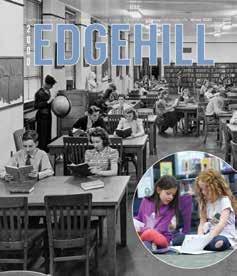
On the Cover
PDS High School students quietly immerse themselves in tomes and novels in the one-room Bruce R. Payne Library in the 1930s. Some 90 years later, young bibliophiles discover a passage together on the lower level of the three-story Hassenfeld Library. Read about the transition between these two spaces on page 6.
University School of Nashville does not discriminate on the basis of color, creed, gender identity and expression, handicap, national origin, race, sex, sexual orientation, or transgender status in the administration of its educational, admissions, and financial aid policies, faculty and staff recruitment and hiring policies, athletics, or other programs or activities administered by the school.
University School of Nashville models the best educational practices. In an environment that represents the cultural and ethnic composition of greater Nashville, USN fosters each student’s intellectual, artistic, and athletic potential, valuing and inspiring integrity, creative expression, a love of learning, and the pursuit of excellence.
2 2000 EDGEHILL



The Magazine of Peabody Demonstration School & University School of Nashville Winter 2020 2 0 0 0 reflections from past to present best educational practices beyond edgehill From the Director 5 Mystery Photos 6 The Academic Town Square 8 Community Spaces 16 When Classes Dismiss 22 Community Time 24 Learning from Afar 28 In the Community 32 Campus News 36 PDS/USN Comes to You 38 Class Notes & Alumni Spotlights 40 Weddings 48 Births 49 In Memoriam 50 6 20 22

4 2000 EDGEHILL
School as a Place
reached a series of campus milestones in this school year, anniversaries worthy of the stories and updates found in the pages to follow. Of course, twin ironies accompany this issue, as it arrives in the shadow of both the tornado devastation to buildings in Nashville and the real possibility of at some point vacating our classrooms to best combat COVID-19. Still, the historical and contemporary importance of teaching, learning, and playing spaces at USN remain, even as we wonder about what might coax out our best in years yet to come.
The Demonstration School, founded in the basement of Peabody College’s Jesup Hall, turned 105 this past fall, while its iconic Edgehill Avenue home building is now 95 years young. Don’t forget even for a minute the architectural significance of its McKim, Mead & White design — drawn by the same firm that built Penn Station, the Boston Public Library, and much of Columbia University. Ours is no small responsibility as stewards of that legacy, and its lines inspired everything we’ve added since, never once subtracting from what was there in the first place.
Maybe you’d be surprised, though, to hear that so many of those subsequent projects are celebrating big anniversaries. How, for example, could the West Wing, the first construction under the USN banner, now be 35 years old? Or the Sperling Center, including what some folks still call the “new gym,” be 30? That facility, named for my esteemed predecessor, though athletics never monopolized his thoughts, is now home to the last few hundred square feet of program space yet to restored to meet emerging program needs. The Edgehill Campus is a living, evolving, neoclassical entity.
Maybe the best modern example of that phenomenon is the Hassenfeld Library, now in its adolescence, turning 15. It seems like we just cut the ribbon to open that gorgeous space, so much more than a repository for books and a place to do homework. The design featured moveable stacks and cases, surrounded by a collection of study rooms. Year by year, the meeting space grows, the reference book section shrinks, and the library’s essential function as a place for groups to gather in common purpose strengthens.
And then there’s the answer to our “big back yard” challenge, the perfect complement to our location at the center of Vanderbilt’s dynamic community — the River Campus. In the catalog of anniversaries, how can it be 20 years since the first games were played out there at the convergence of White’s Creek and the Cumberland? The seven-mile distance to Bordeaux seems shorter as Nashville grows and prospers. And those 80 acres continue to prove resilient, having weathered the great flood in 2010 and just recently the force of winds of more than 120 mph that deposited nine truckloads of debris. And the games resumed there only four days later.
We count on the River Campus more as rosters grow and teams proliferate, and plans call for more amenities to support all that happens there. The other significant project in process carries generational implications, growing from a partnership that reaches back to our earliest days. The original steam pipe that provided heat for the Dem School, linking us to the college across the street, is being retired. Rather than cut that energy cord forever we’re connecting to the new and far more efficient energy loop being built by our university neighbors. And in doing so we strengthen a partnership that reminds us of the singular advantages of our singular location.
Thinking through a decision that promises to matter for decades invites the question of whether our current students’ children will know school as a place, or whether their education might take the form of a series of experiences across a variety of settings. Still, won’t there always be a reason for a central home from which those adventures might emanate? And what will be the role of the digital domain? With the national prospect of pandemic worries pushing us to imagine virtual classes, we’re reminded to think more broadly than ever.
So we strive for a balance, understanding the importance of the spaces that help form our culture every day without defining ourselves by opulent construction. What we have, we continue to treasure, and on this foundation we’ll build something worthy of all the sacrifice, creativity, and wisdom that brought us this far. nn
Working on plans,
Vince Durnan, Director
UNIVERSITY SCHOOL OF NASHVILLE 5
WE
Director Vince Durnan marked the 100th minute of the 100th day of school through song with the Class of 2032 on January 28, 2020.

Mystery Photos
My, how times have changed. We can’t decide if these students are enthralled or confused by the ginormous instruments before them. They certainly look like they are working intently. Do you recognize these students and these giant machines? Who remembers using the old typewriters in the ’70s or the advent of the personal computer in the ’80s? Oregon Trail, anyone? We’d love to hear your stories about life in the classroom before it became customary to carry palm-sized knowledge machines in our pockets. Send your recollections to jtraughber@usn.org.


6 2000 EDGEHILL


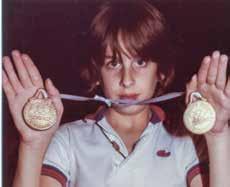
Mystery Solved
Several alumni, faculty, and even a USN parent have helped piece together the four photos of Middle Schoolers during a school version of the Olympics most agree was taken between 1982 and 1984.
Martha Emeson, whose mom Sondra Zendlovitz taught fifth and sixth graders, remembered students working on an Olympics unit during social studies with each group studying a different country.
“She would often talk about what was going on at school when I was at home,” recalled Emeson, parent of Sydney ’22. “As part of the unit, the kids brought in food from their country for a class meal. I’ve always wondered if the International Fair has any roots in the Olympics unit.” She gently reminded us she unearthed and donated medals made of clay to the PDS/ USN Archives a couple of years ago. Students sculpted the medals in then Art Teacher Pat
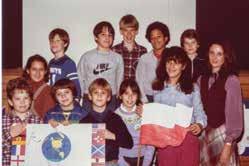
Burress Malone’s class, said Norma Miller, USN Controller since 1977.
Although Catherine “Wynne” Stallings ’88 is pictured in the top right photo, far left of the top row, “I have no recollection of that event!” she wrote. Yet she noted several of her pictured class mates: Ericka Bahner beside Melissa Cohen holding the flag of Scotland; Brandon Hall displaying his two medals; and Tim Ozgener, Arthur Henderson, and Karen Dooley.

Shelbie Freeman ’88 added peers Adam Stein, Joel Atyas, Brandon Hall, Karen Doochin, and Guy Smith; she believes these photos are of the Class of 1988 in sixth grade in 1982.
Sarah Chabon ’79 spotted bearded High School Art Teacher Jose Rodriguez as a judge, Willie Johnson, as well as her stepsister Suzanne Stockard and texted her the photo (oh, the marvels of modern technology). Stockard, who attended USN from kindergarten through seventh grade, leafed through her sister Jessie Rosenblum’s old yearbooks, identified Ericka Bahner, Willie Johnson, and Karen Boles (we’re unsure whether Karen has multiple identities, as yearbooks show only one Karen in the Classes of 1988 and 1989), and emailed with several more clues: “I’m in the back row, far right of the photograph wearing that terrible tan sweater and white collared shirt,” Stockard wrote, recalling her younger self. “The picture is from a Middle School Olympics day where we divided into countries and competed in field events. While you can see a few ‘medals’ around our necks, Scotland didn’t win many events. Mostly I just remember the field games like races and tug-o-war. Vaguely, I remember some classroom content about Scotland.”
with different photos of course, “Olympics Enrich Middle School. Fifth and Sixth graders during December participated in a fall Olympics program here at USN. The purpose (sic) of this event were many; to provide and (sic) interdisciplinary activity; to give students an opportunity to work together between grades, and to provide a multi-cultural experience for the students. The activities ranged from a poetry contest to hearing outside speakers share cultural experiences. The mock Olympic Games lasted three days in which nine global countries, created by the nine advisor groups of two grades, competed for awards. The success academically was equaled in enjoyment.”
The 1982 “Volunteer” says the countries were determined by a poll of the birthplaces of the ancestors of the two grades. They were required to research cultures as well as give an oral and written report before participating in games like a chariot race and javelin throw.
Miller and Bobbie Grubb, retired assistant to the director, immediately recognized Betty Pearson White, who was then Head of Middle School. They also pointed out Mary Emily Taylor, Georgette Hardman (or Georgeann Hardiman), Jose Rodriguez, and Janice Fischer. The awards ceremony was held in the Auditorium. nn
7 UNIVERSITY SCHOOL OF NASHVILLE

Library serves as true academic, community cornerstone
By Juanita I.C. Traughber, Communications Director
There are few times and places the entire University School of Nashville community gathers under one of the school’s many roofs. Yet the Hassenfeld Library is a modernday academic town square where such meetings happen modestly and daily amid its 20,000 square feet. A rare facet of an independent school serving the grade-school spectrum, the K-12 library opened on August 22, 2004. This past fall, USN students, faculty, staff, and trustees marked its 15th year and its vital role in the PDS/USN community.
8 2000 EDGEHILL

Today the Hassenfeld Library is home to 30,058 books, digital resources, and school archives. Upholding their traditional purpose, the library and its six staff develop collections, provide resources to support curriculum, teach research skills, and provide access to technology & global information. “The collection remains meaningful and well used by meeting the needs of the entire community in which it sits,” said Library Director Mary Buxton, who took the helm of Hassenfeld in 2014.
The Hassenfeld Library goes beyond being a repository of books to being a central place in which all USN students — and even their faculty and parents — are able to foster community under one roof. As book collections have been intentionally weeded,
more space has opened for study rooms, relaxing, socializing between classes, and meetings.
In the earliest days of Peabody Demonstration School, pupils used a small collection of materials in the Jesup Psychological Building. The Bruce R. Payne Library, named for the president of Peabody College from 1911 to 1937, opened on November 20, 1925 for the then 10-year-old Peabody Demonstration School on the third floor of the school’s new home. Nynah Heath was the first PDS librarian. Through the Joint University Libraries effort beginning in the 1930s, PDS students could borrow from libraries at Vanderbilt University, Peabody College, and Scarritt College.
9 UNIVERSITY SCHOOL OF NASHVILLE
In Payne Library, shelves filled with mostly reference materials circled the 3,200-square-foot room’s perimeter to maximize space for seating and tables made from maple trees. It was damaged in the 1954 Auditorium fire and also known to occasionally become home to tiny, fourlegged friends who scurried across the floor, frightening even the most gallant students onto table tops.
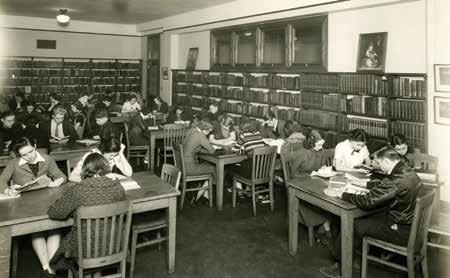
Yet for some time, the school did not consider whether Payne had reached its capacity to house collections and best serve students.
“We made that small space work for so long that it was easy to overlook that we needed a new library. We made it work too well,” said former High School Librarian Jill Eisenstein, for whom a library conference room is named. The longest serving librarian team — Eisenstein and former Lower & Middle School Librarian Martha Hooper, who worked together in Payne and Hassenfeld for 20 years before retiring together — took a neighboring classroom to house Lower School books, deemed it the West Library, and used a small office to process book returns and serve as a space for volunteers.

“At the time it was fine. It was a space where you did your research or went to check out a book to read. The resources have always been excellent. It was peaceful yet with different ages and classes showing up at the same time to find texts and work together,” said English Department Chair Freya Sachs ’00, reflecting on her days as a student.
Yet Hooper and Eisenstein recognized the need for a larger facility and began their own research. Over the span of a decade, the duo visited dozens of libraries as far as New Hampshire and Connecticut, took notes, and captured enough pictures to
fill three hardback photo albums. They found public library branches their best case studies on how to serve a wide range of readers.
Book drops and shelving were obvious. Carrels and small group study rooms were essential with comfortable seating equally as important. Lighting was key. Office space should serve not only librarians but also function as a workroom for students. A classroom with multimedia components for group instruction would be innovative. A grand staircase was a fantasy. And it all needed to revolve around a centrally located circulation desk.
“We felt it was important to address everybody’s learning styles. The main reading room we designed so that we would see all of the kids all of the time,” Eisenstein said. “We wanted a common space for all of the students, faculty, parents, and all of the constituencies that University School serves. We hoped that we would get everybody in the library. The library is a common space, all-purpose place.”
Meanwhile, before formally setting foot on campus as Director, Vince Durnan wrote in his first newsletter column in December 1999 that the school required “a first-rate library to support an academically ambitious curriculum … something truly distinctive in response to our setting and our needs.” Soon, a reaccreditation site visit required a change with standards requiring library seating for 10% of the school’s enrollment. The Payne and West libraries had 52 seats with 978 K-12 students that year.
Hooper and Eisenstein outlined USN’s brick and mortar needs, wrote a program document, and presented their findings to the Board of Trustees Educational Policies Committee along with a
10 2000 EDGEHILL
Nynah Heath was the school’s first librarian, from 1926 to 1940.
Early PDS students study in the Bruce R. Payne Library in the 1930s.


“We wanted a common space for all of the students, faculty, parents, and all of the constituencies that University School serves.” — Jill Eisenstein
12-page report. Three donors immediately stepped up to give $1 million.
“We really pinched that nickel until it squealed in the old space,” Hooper said. “We felt like [trustees] would proceed, but that was the first time in the history of the school that [such a large gift] had happened. It brought tears to my eyes and was the most thrilling thing in the world.”


Soon thereafter, the Development Office began a $15 million capital campaign for a three-story library, an arts building, and to increase endowment.
Construction began on the K-12 library on June 16, 2003 with a groundbreaking for the building designed by architects David
Plummer ’86 (parent of George ‘15 and Max ‘14) and Jim Compton of Everton Oglesby Architects PLLC and constructed by general contractor Quick Foy (parent of Elizabeth ’97 and Suzanne ’00) of American Constructors.
“Working with David Plummer was the best experience because he really listened to what we needed and made the form fit function,” Eisenstein said.
The following year as the school year began, theneighth grader Ethan ’09, John ’75, Tricia, and Heidi Hassenfeld stood in what is now the High School social studies hallway and cut a ribbon to officially open the Hassenfeld Library.
11 UNIVERSITY SCHOOL OF NASHVILLE
(Left) Architect David Plummer ’86, general contractor Quick Foy, and architect Jim Compton pose with an artist rendering of the Hassenfeld Library. (Right) Contractors work in the shell of what would become the Garrison Reading Room. It houses volumes for Middle and High School readers, study tables, the circulation desk, and a charging station.
Jill Eisenstein (left) and Martha Hooper served as USN’s librarians for two decades. After planning the Hassenfeld Library and moving the school’s collection into its new space, they retired together in 2006.

The former Payne Library is now a multipurpose room for receptions, meetings, and classes. The former West Library remains a classroom for Lower School Spanish. Sachs, who returned to USN as a faculty member in 2005 and whose classroom is diagonally across the hall from Payne Library, has its 1925 original shelves lining her classroom walls and holding volumes of Emily Dickinson and Walt Whitman, contemporary novels, American literature, and versions of fairytales from around the world. Because librarians weed collections to purge outdated materials and digital resources offer access to

a plethora of information sources, Hassenfeld’s print collection size is roughly the same as Payne’s was just before the transition.
For as long as its existence, the PDS/USN library has been a dynamic space, the family room of sorts. John Boniol, librarian in the early days after the transition from PDS, regularly wrote columns in the student newspaper detailing the variety of materials being accessioned from the Payne Library, the use of volunteer moms and library assistants, and even a reference to the library being too much of a lounge and needing to be quieter for studying. The librarians of Hassenfeld today deal with the latter issue similarly. Hassenfeld
12 2000 EDGEHILL
John Boniol, the librarian just after the transition from PDS to USN, penned a column in the student newspaper about his wish for Payne to be a quiet study space.
Standing at the Hassenfeld Library’s main entrance — on the second floor where the High School and Lower School meet — Ethan ’09, John ’75, Tricia, and Heidi Hassenfeld cut the ribbon during the grand opening celebration on August 22, 2004.
“And I appreciate as a faculty member not only the chance to collaborate with librarians on additions to the collection but also the chance to think with them about how we’re teaching our students research skills.” — Freya Sachs ’00
is a community space, but they also continue to balance it as a social space and as a study space. Having several study rooms, two with frosted glass dry erase boards gifted from the Class of 2019, are a great help for students to work quietly or do small group work.
Hassenfeld has given Sachs a place to pilot a larger 30-student American Studies class that satisfies both history and literature requirements for juniors and draws from novels, essays, and films, using a variety of perspectives, voices, and stories to study the subjects simultaneously.

Over the years, it has lent itself to Lower School book parties, Commencement and visiting author receptions, displays of fantasy kingdoms built from cardboard and pumpkins decorated as favorite book characters as well as many meetings for curriculum planning, fundraising preparation, and parent-teacher conferences. Almost all High School freshmen are required to retreat there for study hall, yet the library is a popular destination of choice of High Schoolers during lunch, before and after school. Middle Schoolers visit for booktalks, to conduct research, and for after school activities. Lower School students come weekly for library class. It is home to slumber parties during seventh graders’ Out of These Doors overnight trip and the annual retreat for the High School organization Peer Educators & Assistants. A baby shower, bridal shower, and proposal for engagement have even taken place between its walls.
The PDS/USN Archives, formerly carved on the third floor in 2014, houses century-old china, yearbooks, anthologies, and even trophies and a letterman jacket from the school’s earliest days and evolution since. Nearby is a lending library of textbooks donated by students for use by their peers who receive need-based scholarships.
Spaces were subdivided in 2018 to create more study rooms offering small groups additional room to collaborate. A new conference room was built in a previously underutilized space opposite the Archives on the third floor East Mezzanine in 2019. On the West Mezzanine the art collection was weeded so that it could be reshelved between the 600s and 800s, and the Zendlovitz Reading Area was reimagined with welcoming seating. Even a charging station has been added in a corner for students to power cell phones and laptops. On the lower level, the Bennett Klein Story Room and Lower School area beckon the school’s youngest readers with bright carpet, multiple seating options, and an extensive collection. Librarians invite parents to borrow from the collection and volunteer to reshelve books and curate collections for them to borrow.
“It’s incredibly useful to be able to walk down the hallway with students to find a volume of contemporary poetry that I want them to be able to read on our shelves. It’s a great space to have individual conferences and meetings with students,” said Sachs. “And I appreciate as a faculty member not only the chance to collaborate with librarians on additions to the collection but also the chance to think with them about how we’re teaching our students research skills.”
Librarians regularly wheel red carts of books to classrooms and weekly division meetings to bring new additions and award-winning books to students. They still work to connect High School students with resources in Vanderbilt University’s libraries as well as to introduce seniors to libraries at the colleges to which they will matriculate.
13 UNIVERSITY SCHOOL OF NASHVILLE
2019-2020 Library Staff: Jenny Winston, Archivist; Kristin Frank, LS Library Assistant; Emily Theobald, LS Librarian; Mary Buxton, Library Director; Catherine Lemaire Lozier, Library Assistant; Kate Pritchard, MS/ HS Librarian
“We want to be able to respond to our community’s needs. What we’ve done is take a look at the physical space with a flexible mindset and adapted it to meet multiple uses that we’ve become aware of and those we don’t even know yet,” Buxton said. “And we continue to move the collection forward by being flexible and responsive as curriculum changes and provide Lower School classrooms with enough of a collection to support a wide range of reading levels and support the needs of early literacy.”
Buxton’s growth mindset comes to reality with the generosity of the parent organization, University School of Nashville Association. Parent volunteers began the used book and media sale that circulates more than 25,000 books from the hands of spring cleaners to bookworms across the Nashville community in the fall. Books leftover at the end of the three-day sale are donated to public schools and area nonprofits. Upwards of $12,000 is gener-
ated annually as an unrestricted fund for the library. It has been used to add a hydration station and furniture, upgrade computers, bring in authors for three-day residencies and other visits throughout the school year, and update the nonfiction collection.
Buxton recently discovered many beloved book jackets and called USN parents Judith and Richard Feaster (Philip ’23) — experts in identifying and selling books of extraordinary historical significance — for their assistance in researching and potentially selling them. In December 2019, they matched a jacket designed by Ellen Raskin to the first edition of Madeleine L’Engle’s 1962 A Wrinkle in Time and sold it for $1,000. What an unexpected gift from the past. nn
Editor’s note: Archivist Jenny Winston contributed extensive research to this article.

In 2001, USN launched a five-year capital campaign, The Campaign for Arts & Letters, to raise funds to construct a new library and visual arts center and to increase our endowment. The January 2006 dedication of 1980 graduate John Medwedeff’s bronze installation at the corner of 21st and Edgehill Avenues marked the successful completion of those projects, celebrating the creativity of students, faculty, and alumni on this historic campus.
2000 EDGEHILL
14
15 UNIVERSITY SCHOOL OF NASHVILLE
COMMUNITY SPACES
The Passage of Time
By Jenny Winston, Archivist
Sperling Cafeteria
Thirty years have passed since the Sperling Center opened. Named for beloved Director Harvey Sperling (1979-1990), the building includes a second gymnasium, new cafeteria, and the addition of performing & fine arts classrooms. It was dedicated on a Sunday afternoon, September 24, 1989. The cafeteria underwent substantial renovations to the kitchen and serving area as well as the addition of a High School lounge and expanded seating in 2011. A far cry from the nutritional trends of the late 1980s, today’s Sperling Cafeteria serves breakfast, lunch, and a snack with gluten-free, vegan, and vegetarian options daily, plus a full salad bar. nn

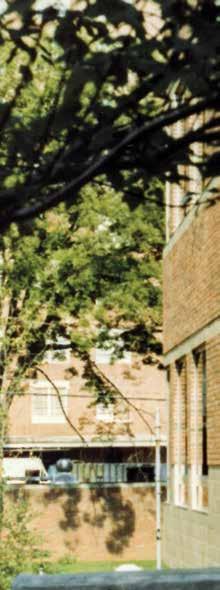

16
2000 EDGEHILL


Sperling Cafeteria By the Numbers
500
approximate number of meals served a day
Wednesday
most popular day in the cafeteria, serving house-fried chicken sandwiches with mac & cheese or potatoes
20 lbs.
bulk weight of edamame consumed by Lower Schoolers from the salad bar each week
45
top number of house-made pizzas cooked in a day
Ranch
hands-down most popular condiment, housemade with fresh herbs daily
17
UNIVERSITY SCHOOL OF NASHVILLE
COMMUNITY SPACES

Auditorium
This past summer marked 65 years since the Auditorium suffered a fire, early one June morning in 1954. Though the fire remains its most significant event, the Auditorium, original to the 1925 building, has undergone plenty of changes in its 94 years, both in space and use. Students from decades past might remember performing in plays on the stage, registering for classes before the opening of the school year, attending proms or Commencement ceremonies in the Auditorium. And who can forget the first Grandparents’ Day in the Auditorium in 1982 — just a modest production at the time.
In July 2019, construction crews replaced the brick mortar on the western exterior side of the Auditorium. They will finish the remaining sides in summer 2020. Though many of our musical and theater performances have outgrown the Auditorium, you will still find it bustling on most days with rehearsals, alumni or parent gatherings, and of course weekly assemblies for students in each division. Read more on how the Auditorium continues to foster a sense of community among students on page 22. nn
18 2000 EDGEHILL

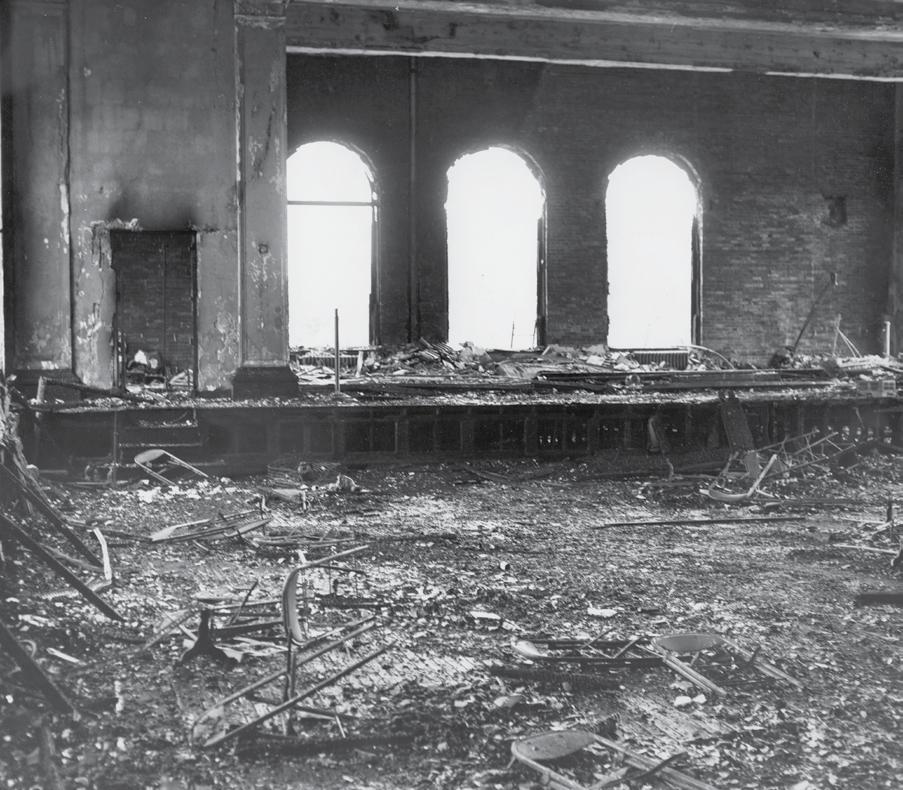

19 UNIVERSITY SCHOOL OF NASHVILLE
COMMUNITY SPACES

River Campus
Twenty years ago this past September, the USN girls’ soccer team played against Northwest in the first interscholastic athletic contest on the new fields along the Cumberland River. Serving initially as home fields for High School girls’ soccer and Middle School boys’ and girls’ soccer, the freshly designated River Campus was celebrated by families and fans with a fall picnic following the women’s game against Battle Ground Academy on October 7, 1999. Today, the 80 acres are home for all competitions in baseball, lacrosse, soccer, softball, tennis, track & field, and Ultimate frisbee and are used for environmental education and wetland research. An EF-3 tornado devastated Nashville on March 3, 2020, leaving River Campus fields strewn with debris and scoreboards, fences, and bleachers damaged. nn
20 2000 EDGEHILL



21 UNIVERSITY SCHOOL OF NASHVILLE
After-School programming a growing destination for families
By Rebecca Stokes, After-School Director
Apopular destination by necessity and choice, the AfterSchool and Middle School After-School programs have reached a record enrollment of students this academic year. These programs take place after the regular school day when many parents are still at work and include homework help, organized crafts, opportunities for free play, optional enrichments, and celebrations of holidays and cultures. Their success is nothing new to USN and is increasingly recognized by our national peers.
Child Magazine named the After-School program as one of the top 10 programs in the country in August 1994. Since its inception 30 years ago, the program grew from its original 15 students in grades K-2 to include both Lower School and Middle School divisions and boast an enrollment of about 200 students with Beth Thornburg at the helm from 1983 to 2017. Beth attributed the success of the program to the “neighborhood atmosphere,” telling the magazine that “in an old-fashioned neighborhood, kids had many choices, freedom of movement, and chances to play with younger and older kids. Above all, they felt safe; that’s the feeling we’re trying to create.” That sentiment is still at the heart of the program today, and with active enrollment topping 400 families, our neighborhood keeps growing.
As the program developed, Beth set aside the traditional model of having each grade level move in isolated groups from activity to activity assigned to one or two particular staff and opted to build something a bit different — a mixed-age, entirely child-choice driven program. She created the scaffolding of the “unstructured” afternoon by positioning a larger than normal staff in stationary locations and allowing students to move freely throughout the space as they liked and in their own time. The decision not to separate the grade levels beyond division was key to preserving the neighborhood feel and acted as a catalyst for building community, allowing students to develop relationships outside the bounds of their classrooms and across grade levels. In the Lower School After-School program, it is not uncommon to find kindergartners and first graders engaged together in imaginative play, a third grader teaching a second grader to knit or play a game, and any number of students reading to one another or
“In an old-fashioned neighborhood, kids had many choices, freedom of movement, and chances to play with younger and older kids. Above all, they felt safe; that’s the feeling we’re trying to create.”
— Beth Thornburg
creating art together. Fourth graders, now a part of the Middle School After-School program, find their time there eases the inevitable transition from being the old pros of Lower School to the new kids on the block in Middle School. Older students have natural opportunities to test their leadership skills, and families find their network of relationships expanded.

2000 EDGEHILL 22

As we play, grow, and work together we all become richer from the diversity of individuals that make up our community. For years our celebration days have highlighted the best of us, and they continue to bring so much fun into each opportunity we have to learn from one another. Among them are the well-established annual Chinese New Year, Diwali — the Hindu Festival of Lights, and Black History Month celebrations as well as the new and exciting additions of celebrations teaching students about Ramadan, Hispanic Heritage Month, and winter holidays spanning several religions and cultures. We never pass up the opportunity to throw a party. These special days would not be possible without the hard work and support of parent volunteers who have been instrumental not only in throwing a party for 300 people but also in shaping our learning leading up to these days. The contributions they willingly and proudly make to our community, along with those of our students, really deepen the experience for us all as we broaden our understanding of each other’s culture and heritage, as I shared when presenting to my peers about inclusive programming during the Summer Programs and Auxiliary Revenue Conference this October.
We have worked hard over the years to preserve the freedom for children to play, create, experiment, imagine, and learn on their own terms, while at the same time striking a balance with the structure necessary to pull it all off. We find a measure of that balance in our selection of enrichment classes offered each afternoon. Taking into consideration the many requests we receive from parents and the gig economy that brings an abundance of instructors offering new classes to us each year, we carefully consider the value each one might add to the program and to each child’s experience. Beginning in 1979 with French and gymnastics classes, enrichment options have grown to include Spanish, Chinese, guitar, violin, filmmaking, journalism, robotics,

I became a part of the After-School staff in fall 2002 and had the pleasure of working alongside and learning from Beth until her retirement in spring 2017. Beth worked to build the program’s strong foundations, and we move forward with great appreciation for that work. The wonder of technology has allowed us to streamline logistics and become more flexible for the modern family. The recent overhaul of our tuition and billing structure has increased accessibility to the program for families, opening the door for even more USN students to join the fun.
We have made changes along the way as our numbers have grown year after year — adjusting the age groupings as physical space will allow, leaving the piles of paper behind as we moved fully into the digital age, and setting our focus on the social and emotional growth of our students. Our neighborhood has grown much bigger over the years and now includes a large majority of the greater school community. It is my honor to act as the community organizer, to carry on its strong traditions, and to create new ones alongside a dedicated staff, engaged parents, and a brilliant group of young people. nn
UNIVERSITY SCHOOL OF NASHVILLE 23
engineering, American Sign Language, and a variety of art and dance classes. There are even field trips on nonschool days.
(Opposite page) Knitting is a popular pastime of Harper Hughey ’29 and students who stay at school after 3 p.m. (Above) A month-long celebration of Hispanic heritage began in After-School on September 18, 2020 with papel picado art and food with families. (Right) After-Schoolers can opt into enrichment activities, like ballet, that are conveniently taught on campus by adjunct staff.

Community Time
Regular gatherings foster community, build citizenship
From the moment students step into the brick buildings at 2000 Edgehill until they walk across Magnolia Lawn as graduates, there is a continuous thread in the USN experience around community. In each division faculty and staff prioritize community building and devote time to the deliberate and direct instruction around what community means and what it means to be a positive contributor to one’s community. Students engage in age-appropriate instructional and experiential activities intended to set a solid foundation and build a sturdy structure around being a contributing member of a community.
24 2000 EDGEHILL


Lower School Assembly
By Amy Woodson, Head of Lower School
don’t have to look far for the resources and pedagogical markers to begin laying the cornerstones in the Lower School curriculum around community building. The Responsive Classroom philosophy informs our community efforts daily in individual classrooms and weekly in divisional experiences so students can do their best learning.
We emphasize creating communities of trust and developing a sense of belonging, significance, and engagement by beginning the day with a Morning Meeting and ending the day with a similar Closing Meeting. In Morning Meetings, we practice a daily check-in for individualized personal sharing, to learn about others, and to practice social communication skills. The meetings are a place where we build in education about key social-emotional skills, such as cooperation, assertion, responsibility, empathy, listening, and self-control.
We devote time each week to a divisional gathering in the Auditorium. This Assembly is akin to a family commitment to eat supper together. We begin by singing the alma mater, an act so oft-repeated that alumni can still sing it as adults. Students and faculty alike come to the microphone to introduce themselves and celebrate their birthdays. Classes take turns sharing projects and field excursions. We have heard a visiting author walk students through the themes of her book and its accompanying music. We have even used this time to keep track of a teacher hiking the Appalachian Trail.
Class activities and projects, Journeys and Forest Days, and Grandparents & Special Friends’ Day at their essence are about community building. We place a high priority on building the emotional and intellectual muscles for our students to be caring, compassionate, and respectful. Director Vince Durnan often mentions the “secret sauce” of USN and surely Lower School’s Morning Meetings and Assemblies work as key ingredients.
(Above) Lower School Assembly always begins with students standing to sing the school Alma Mater as Music Teacher Doni Princehorn plays on piano the piece she composed. During an Assembly this fall, Bryard Huggins ’13 taught Lower Schoolers a song he wrote with former USN student Alexandria Churchwell to accompany a book written by her mom.
25 UNIVERSITY SCHOOL OF NASHVILLE
WE

Middle School Town Meeting
By Jeff Greenfield, Head of Middle School
High School Assembly
By Quinton Walker, Head of High School
it’s happening in the Auditorium and involves Middle School students, you can bet it’s important and it’s about community. Our weekly Town Meetings take place there and are times to celebrate student accomplishments and kindnesses. Occasionally we feature guest speakers and performers, always with a message circling back to one or more of our core community values. With only rare exceptions, our student musical and theatrical performances take center stage in this same Auditorium, as do our biggest celebratory events of the year, namely the Eighth Grade Breakfast and our Recognition Assembly, both in May.
Getting together in the same space on a predictable basis is crucial for pre-adolescents to understand the community they are part of. Real community is more than a catch phrase or even shared values; it’s a personal promise to put the good of the whole above one’s desires. When our Middle Schoolers can actually see those people who comprise our Middle School community, it helps hold each of us accountable for bringing our best to the group each day.
S IFAstudents move into High School, USN encourages each student to think conscientiously about the community they are entering. Our work capitalizes on the increasing amount of student voice and engagement the Lower and Middle Schools encourage during their respective communal endeavors.
We acknowledge the premise that school doubles as community. Still, it’s a delicate balance we walk in the High School. If we adults stand back passively, we can’t be quite certain what communal norms and cultures emerge from students. If we intrude and guide too heavily, it never really becomes their community. As such, we’ve moved to a model that builds community at multiple levels and in multiple ways throughout the High School. With the advent of a new six-day rotating schedule, we have devoted increased time for community gatherings during Assemblies, class meetings, student-led meetings, advisory, and special programming held in the heart of the day. Once weekly, we host a division-wide Assembly in the hardest working room in the school. There, students and faculty make announcements, acknowledge peers for jobs well done, and listen to talks from faculty. It’s mostly student-led, and by design — we want our students to take responsibility for the tone and the content of our time together, precious as it is. On other days, we have smaller
26 2000 EDGEHILL
Town Meeting on Halloween is a lighthearted show of sorts. Fifth, sixth, seventh, and eighth graders go through several rounds of cheers for classmates to vote for the best costumes in several categories.


breakout groups based upon need — a junior class meeting to talk about the class fundraiser for Prom; a freshman meeting to talk about leadership opportunities; a student-led club meeting to prepare for the Home Run for Habitat or Spaghetti Supper. These spaces reinforce the communal principles of shared purpose and student agency.
We’re intentional about making space for community and recognize the need for our students to take active roles in sustaining that community. nn
(Above) Parent of alumni and Metro Councilwoman at-Large Burkley Allen speaks to freshmen, sophomores, juniors, and seniors during the weekly High School Assembly in October. (Left) Neil Narayanan ’21, Yenni Gonzalez-Salinas ’21, and Victoria Christianson Galina ’20 with Aliados, a USN student organization for Spanish for allies, invite classmates and faculty to attend their November celebration of cultures among Latin Americans.
27 UNIVERSITY SCHOOL OF NASHVILLE
 By Kelicia Cox, Assistant Head of Middle School
By Kelicia Cox, Assistant Head of Middle School
Critical learning takes place outdoors in Middle School
The chance for Middle Schoolers to travel away from school with classmates and teachers and try something new together is an opportunity for connection. Through the eighth grade Washington, D.C. trip, seventh grade Out of These Doors trip, sixth grade Pisgah National Forest trip, and fifth grade Land Between the Lakes trip, students find their strengths and have them acknowledged or affirmed by a teacher or a classmate while away from the regular academic school day.
28 2000 EDGEHILL

“The best part of the experience was simply watching bonds form and tighten.”
—Sixth Grade English Teacher Yue Yuan
Seventh Grade Science Teacher
Heather Campbell Webber ’82 said, “In the world of the seventh grader, few considerations command more attention than interaction with classmates. Out of These Doors, the three-day seventh grade class trip, was designed, in part, to give students a chance to forge meaningful friendships with people they might not know very well. Social dynamics change, and it turns out that kids (in addition to learning a little something) bond more deeply and also have a blast.”
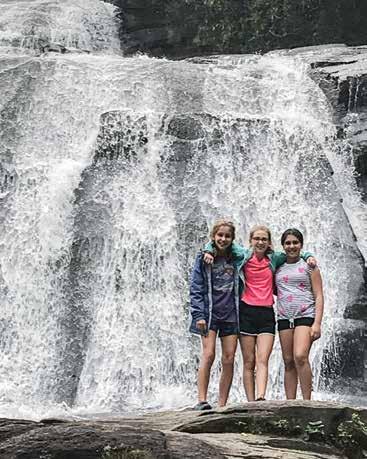
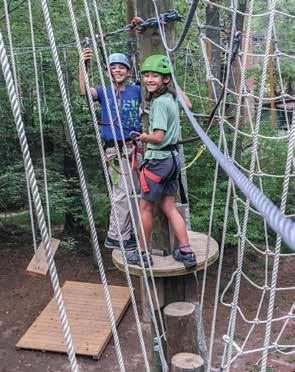
First time Pisgah wanderer and Sixth Grade English Teacher Yue Yuan added, “The best part of the experience was simply watching bonds form and tighten. Kids from entirely different social circles cheered each other on in team competitions or as they teetered high above in the Sky Park ropes course.”
Community, connection, education, and having fun are integral parts of these class trips. They provide impressionable learning experiences in civic engagement and responsibility, history lessons, scientific and mathematical evaluating, environmental and conservation studies, culinary arts, and etiquette. And in the words of Fifth Grade English Teacher John Kleiner, things “that we cannot replicate in our classrooms, such as outdoor survival skills, orienteering, and ecosystems studies.” Seventh graders’ options for their small group field trips this school year included caving,
29 UNIVERSITY SCHOOL OF NASHVILLE
(Opposite page) Seventh graders pause while venturing into Cedar Ridge Cave, which was discovered in the 1960s during blasting for I-24 construction. (Above) Sixth graders explore the Pisgah National Forest and its waterfalls as well as complete several team- and confidence-building exercises.

cooking, rock climbing, sailing, riding roller coasters, hunting ghosts, and training in some of the more obscure upcoming Tokyo Olympics events.
In these experiences, it is also essential that Middle Schoolers gain a sense of what it means to be in community with one another and learn the key components of relationship building and collaboration. That may include having opportunities to resolve unpredictable issues and to learn how to handle minor setbacks. In those vulnerable moments, it is important for us all to learn to practice self-care and self-regulation. For some of the youngest members of the Middle School community, the conversations around these topics starts early.
“Some of these children are camp veterans used to spending six weeks away from home every summer. For others, this is their first time away from mom and dad. Ever. All are excited, maybe even a little anxious,” Kleiner said.
Each year Middle School faculty spend a great deal of time thoughtfully and carefully planning each school trip to make it
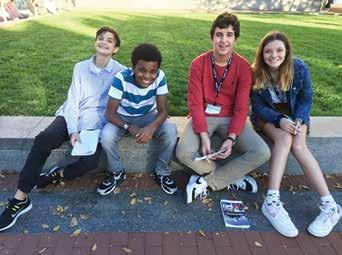
developmentally appropriate, to ease initial nervousness, and to make it a fun adventure for everyone. Teachers consider individual students’ needs and personalities of each student when placing them into groups for the trips.
“Each minute was considered precious at our annual Pisgah trip. Casting off notebooks and iPads for a week in the North Carolina mountains, we instead got ready to traipse across the rugged landscape. Several students were hesitant at best, skeptical at worst. ‘What types of bugs are going to be in my cabin? Will I even like anyone in my camp group? How am I going to survive a whole four days with the whole sixth grade?’ Still others anticipated the ideals of camp. ‘Will there be s’mores? Are we camping
2000 EDGEHILL 30
Eighth graders’ tour of the nation’s capital includes visiting landmarks as well as time to socialize with peers outside of their regular friend groups.
We, as a school community, value experiential teaching and learning, and they are significant parts of our program.
outside at night?’” Yuan said, recalling early conversations.
“Despite the hesitation, students thrived in the sunshine of the trip. In weathered boots, they hiked to see crashing waterfalls. Armed with a personal floatation device and some courage, they sped shrieking down ziplines.
With uproarious cheers, they chased each other in games of Farkle and Gaga ball. You could not escape the infectious joy of students in Pisgah,” she said.
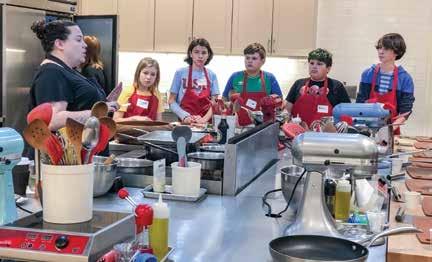
Giving students the freedom to mess up and try new things creates curiosity and invites deeper motivation to engage, which can translate to learning that happens in the regular academic school day. We, as a school community, value experiential teaching and learning, and they are significant parts of our program. In those moments, there are skills a student can acquire like reasoning and solving problems with their peers, finding the right balance for themselves and for others, establishing how long something might take to complete, and consciously predicting and preparing for potential challenges.
For this reason, the grade-wide overnight field trips have been an integral part of our curriculum for almost two decades, Kleiner said.
Getting the eldest group of students of the Middle School to engage while having fun on the Washington, D.C. trip can be a bit humbling. Teenagers in their levels of excitability present a little differently from younger Middle Schoolers.
“Why travel with 80 eighth graders to Washington, D.C. when we have a 24/7 news cycle that keeps us constantly informed of our national government?” asked Eighth Grade History Teacher Jared LaCroix. As he competes with digital offerings to share the im-
portance of government with 12 and 13-yearolds, students leave their cell phones and other technology at home during this trip.
“Talking about the government is a better bet, but students still elicit their digitally informed imaginations in these conversations. Thus, the government remains elusive, something hovering over us like ‘the cloud.’” We are not sure exactly what it is but do know that it is big and always present,” LaCroix said. “To stand beneath the 288-foot dome of the U.S. Capitol, to shake the hand of a conservative and a liberal lobbyist, to see the construction project on the White House — the images and information that dominate our screens occupy real space, and by encountering the physical reality of the government, politics become demystified as it takes a human shape. Politics lose some of its reflective gloss as you realize time is real and wears down buildings, people, and ideas. And as the government becomes more human, students can begin to see themselves as belonging to the process. Their imaginations become informed by physical reality and conversations about civic responsibility and possibilities become as real and significant as their eighth grade trip.
Doing something that may be uncomfortable today, in the presence of caring adults, may in the future be one of those enjoyable moments for memories that will last a lifetime. Students using their imaginations and not settling for what they are, when they are out on some of these trips, gives them the chance to create and try on who they want to be. In Middle School, we value helping others not only to see the importance of finding and maintaining a sense of balance in their lives but also making it a priority there too. nn
To read an expanded version of this article and see more photos from Middle School retreats, visit usn.org/publications .
UNIVERSITY SCHOOL OF NASHVILLE 31
Out of These Doors meant into the kitchen for seventh graders who made pasta and rolled sushi at Sur La Table in Brentwood, Tennesee.
For 24 years, High Schoolers have paused their academic studies to spend a day engaging with the community.
Community Action Day
November 4, 2019

Sam Horner ’20, Victoria Christianson-Galina ’20, Lauren French ’21, and Martin Parra ’21 planned this year’s Community Action Day, which ended with reflections on volunteer experiences in small groups and an ice cream social.
“Don’t worry about what the end results of what your efforts are going to be because what matters is the collective effort.”
—
Claude Gatebuke
Community Action Day opening speaker, Rwandan genocide survivor, and human rights activist

2000 EDGEHILL
32



Students walked and rode buses to neighborhoods across Nashville to 34 schools and nonprofits, including Thistle Farms, Darkhorse Theater, LP PENCIL Box, Abe’s Garden, and the Global Education Center. Service projects build upon existing ties between High School clubs and the community as well as foster new relationships.
UNIVERSITY SCHOOL OF NASHVILLE
33
Campus NEWS

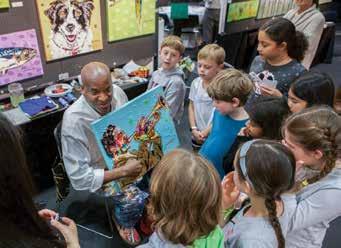
k Art lovers took notice of the colorful efforts behind Artclectic
The event yielded several records: greatest sponsorship dollars raised, most Patrons Party tickets sales, a 22% increase in art sales, and made the largest donation — over $100,000 — to the Artclectic Endowment for Innovative Teaching.


k The Chess Team brought home many trophies and medals during its fall tournaments. Matthew Golann ’29, Preston Chan ’29, and Stewart Hall ’25 earned coveted spots in the 2020 Nashville City Championship. Only six students who live within a 50-mile radius of the Nashville Chess Center get to participate in this event at each level.

2000 EDGEHILL
34
k The Middle School boys’ varsity soccer team earned the title of 2019 HVAC AA Tournament Champion with a shut-out victory over Lipscomb Academy.
2019.
k The YMCA Center for Civic Engagement honored High School History Department Chair Mackey Luffman with its Mike Buhl Award in August for his work promoting civic responsibility and inspiring intellectual discourse among students.

Corp.

12% of the Class of 2020 for top
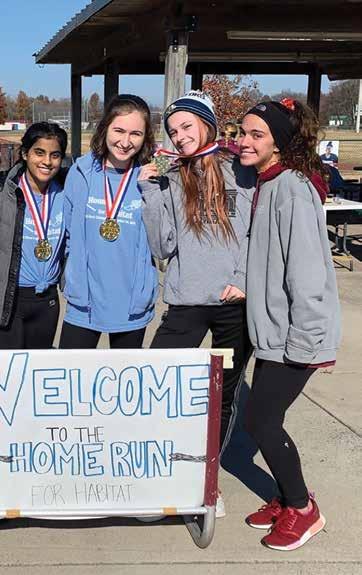
scores.
, The High School Habitat for Humanity Club hosted a 5K and 1.5-mile kids fun run in November at the River Campus and raised nearly $4,000 for its spring home build.

k Fall Book Frenzy raised more than $15,000 for Hassenfeld Library during its three-day sale in September and donated books to Metro Nashville Public Schools teachers. Book collection will resume in the spring for the fall 2020 sale.
UNIVERSITY SCHOOL OF NASHVILLE 35
k The National Merit Scholarship
has recognized
PSAT
Quinn Booth, Ian Brash, Jacob Green, Claire Kim, and Cole McMillan are semifinalists. Yoshi D’souza, Seth Ellis, Joshua Esquivel, Timothy Hays, Arushi Mehta, and Trevor Zou are commended students.
Campus NEWS





2000 EDGEHILL 36
k Middle School Theater began the school year with “Frozen Jr.” Their costumes, handmade by USN parents and sets built by fellow Middle Schoolers, are now being leased by schools and theater companies nationwide.
k “Legally Blonde The Musical” was a barking success USN for a Spotlight Award. A first for High School Theater,
k Kunaal Singh Saggi ’21, Greydon Franck ’21, Claire Kim ’20, and Anne Griffin ’22 sketched a chalk display during the 20th Anniversary El Día de los Muertos festival at Cheekwood. USN’s altar by Lower School Spanish Teacher Arcelia Vazquez was named Trendiest Design.
k The boys’ cross country team is the 2019 TSSAA Division II Class A State Champion. Timothy Hays ’20 was crowned the individual champion with Pelham Bergesen ’20 as runner-up. The girls’ cross country team landed on the podium in third place.
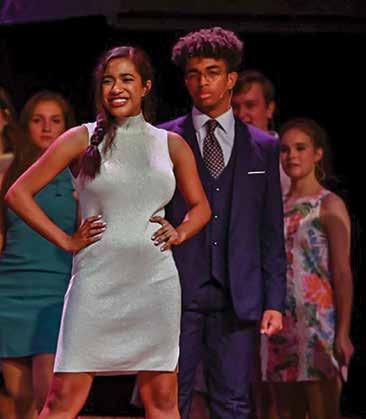


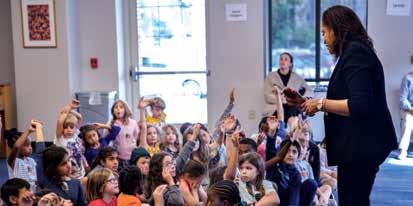

k A record number of 84 USN students participated in the YMCA of Middle Tennessee Model United Nations Conference in November. Claire Kim ’20, Olivia Rhee ’20, Nicholas Key ’20, Wei Dai ’20, and Yoshi D’souza ’20 served as officers in charge of facilitating conference activities. More than a dozen USN students earned Outstanding Resolution and Statesman Awards.
, Seventh Grade Math Teacher Joel Bezaire earned a 2019 Desmos Teaching Fellowship and visited its San Francisco headquarters in July to learn about the intersection of math, teaching, and technology.
UNIVERSITY SCHOOL OF NASHVILLE 37
with four soldout performances. The Tennessee Performing Arts Center is considering the cast included four canines.
k Five dozen Trustees who have shepherded USN since 1975 returned to 2000 Edgehill for a reception in November. Also in attendance was former Director Harvey Sperling.
k Author Gloria Respress-Churchwell, former USN student Alexandria Churchwell, and Bryard Huggins ’13 returned to USN in October to teach students important life skills through Gloria’s children’s book “Follow Chester!: A college football team that fights racism and makes history.”
Out of Town Alumni Events
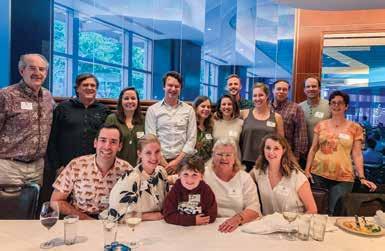

Seattle
Top left to right: Director Vince Durnan, John Wood (parent of Crosby Wood ’30), Mary Schmid ’01, Sam Shaw ’15, Anne Wilson ’02, Patrick Quinn ’07, Nicole Southwell ’04, Brooke Weitz ’97, Eric Jewett ’91, Aaron Cramer with friend Lauren MacDonnell ’93;
Bottom left to right: B.J. Stein ’02 and wife Leah Stein, Crosby Wood ’30, Simone Leblon ’78, Alexandra Kinzer Nienhuis ’04.
Dallas
Back row left to right: John Buttrey ’00, Liam Fitzgibbon ’19, Harrison Kisber ’19, Cameron Rosenberger (guest of Liam Fitzgibbon and Harrison Kisber), Jeff Ray ’76, Ian Ray (son of Jeff Ray)
2000 EDGEHILL
38
1
Front row left to right: Julie Jennette Barnes ’77, Tate Elliott ’17, Morgan Wexler Laughlin ’08, Rob Andrews ’03
n
usn.org/alumni

Boston
Front row left to right: Alumni Director Patti Wexler, Mary Atkins (parent of Abby Motycka ’13 and Eli Motycka ’13), Scott Sudduth ’54, Tamara Bliss (grandparent of Will Barrett ’22); Second row left to right: Henry Spradley ’09, Jillian Berkman ’08, Rodney Lister ’69, Gail Sudduth (wife of Scott Sudduth ’54), Elizabeth Lunbeck (parent of Sam Gerstle ’09), Jane Hardy (parent of Tom Kochtitzky ’15 and Will Kochtitzky ’12), Head of High School Quinton Walker; Third row left to right: James Greer (husband of Jillian Berkman ’08), Kayla Servin with friend Malcolm Moutenot ’13, Matt Hills ’77, Jonathan Roth ’06, Gary Gerstle (parent of Sam Gerstle ’09); Back row left to right: Director Vince Durnan, Chris Teal (parent of Ellie Teal ’09), Dylan Groos ’15, Allison Pingree (parent of Emma Pingree-Cannon ’11), Michael Puett ’82. Present but not pictured: Lucy Gilbert ’78, Sam May ’15, Eric Rosenberg ’75, Kimberly Steadman ’93.
Chicago
Front row left to right: Milan Opsenica (fiance of Sam March ’09), Callie Sands ’18, Kelsey Magnuson ’11, Marissa Koven, Madeline Baxter ’18, Estella Mosley ’18; Back row left to right: Eitan Korrub with friend Kayla Ducklo ’10, Dillon Goodson ’07 and wife Abby Goodson, Angi Pile-Morris (parent of former students Austin Morris and Christian Morris), Gayle Brinker (parent of Dillon Goodson ’07), Sam March ’09, Director Vince Durnan, David Brown ’83, Jennifer Plumridge ’08, Chief Financial Officer Teresa Standard, Alumni Director Patti Wexler. Present but not pictured: Abby Michaud Arnold ’02 and husband Charlie Arnold.


Washington, D.C.
Front row left to right: Adam Fagen ’89, Hannah Edelman ’08, Ella Mathews ’12, Aliza Sir ’09, Hannah Laibinis ’19, Ariel Neaderthal Voorhees ’01, Camille Smith Espinoza ’97, Annual Fund Director Claudia Huskey, Mark Stumpf ’65, Barrett Witkin ’96. Middle row left to right: Thomas Snow ’04, Sam Gerstle ’09, Julia Garrison ’08, Michael Snow ’06, HS Teacher Ann Wheeler, Peter Ansoff ’71, Naomi Patton ’06, Ken Jost ’65, Michael Davies ’88, Ben Kuhn ’15, Alec Eskind ’14, Elliott Clark ’19. Attended, not pictured: Michael Friedman ’88 and Ben Lundin ’03.
UNIVERSITY SCHOOL OF NASHVILLE
39
1
CLASS NOTES

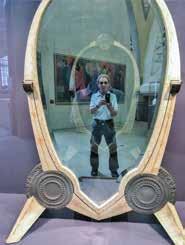

1955
Morris Werthan ’55 and wife Libby celebrated their 60th wedding anniversary. They are also the proud great grandparents of a little boy born to Hannah, their granddaughter and daughter of Michael and Helen Werthan.

1956
Steve Riven and wife Jan have established a directorship in cardiology at Vanderbilt University in memory of his father, Samuel Riven, a cardiologist who served on the Vanderbilt faculty for more than 50 years.
1962
Knox McCharen and friends from the Class of 1967 visited campus this summer.
1967
Dick Stelzer shared a photo he took in Paris in July. It is a reflection of himself in a giant mirror behind glass at the Musée d’Orsay.
Nancy McCharen , Barbara Cooper Wilkins, and Cassandra Teague-Walker stopped by for a school tour and visit.
Rosemary Zibart visited USN in November to speak about her latest book, “Beatrice on her Own.” She writes historical fiction and discussed her writing and research process with fifth graders.
1968
The Class of 1968 gathered for lunch. See photo above.
1971
Barry Wilker traveled to Tangier, Morocco in October.
The Class of 1971 meets for lunch the first Tuesday of every month at Noshville in the Green Hills area of Nashville. For more details contact Alumni Director Patti Wexler.
continued on page 40
2000 EDGEHILL
40
Libby and Morris Werthan ’55 Dick Stelzer ’67
Left to right standing: Barry Kammerud ’68, Shannon Paty ’68, Diana Blackwell Wiles ’68, David Steine ’68, Sam Stumpf ’67; Left to right seated: Trey Lipman ’68, Cassandra Teague-Walker ’67, Bonnie Magid Small ’68.
n usn.org/alumni
Left to right: Knox McCharen ’62, Nancy McCharen ’67, Barbara Cooper Wilkins ’67, Cassandra TeagueWalker ’67, and David Bellama.
BeyondEdgehill Fabienne Engel Stassen ’74
Fabienne Engel Stassen ’74 moved to Geneva when she was 17 years old and a recent graduate of Peabody Demonstration School. Her educational experience and the values she learned at PDS have made a significant impact on her successful professional career. She spent 15 years working for the World Economic Forum as an editor. Today she is an English language editor and owns an editing company.
Q: What inspired you to move to Switzerland?
A: I like the cultural diversity of this very international city.
Q: Tell me about your career.
A: I’m an English language editor. I started my own company, EditorProof, in 2012, after working for the World Economic Forum as head of the editing department. We edit documents for agencies and programs of the United Nations as well as for businesses, nongovernmental organizations, international financial institutions, and private individuals. The work I’ve done has allowed me to interact with heads of state, chief executive officers, academics, renowned scientists, and others who have acquired fortune and fame. What might surprise some people when I speak about these encounters is that all these people are basically the same. We’re all human.
Q: What is your fondest memory of PDS?

A: I have many fond memories of PDS, starting in 5th grade. Most of our teachers were amazing: Mrs. Hitchcock in English; Lorena Edwards in typing; Robert Moser in algebra; John Colozzi in history; Thomas Stitely in social studies, to name a few. I was captain of one of the four intramural teams. We played soccer and field hockey after school. We had a great PE teacher named Gracie Allen so we enjoyed
all the activities we did outdoors. I also liked the fact that the school had a pool. I remember lifeguard training in the pool, which was a lot of fun. Back then, we would play the card game spades on the school premises between classes or cross the street and sit on the college lawn to study or chat. I was fortunate to have an idyllic childhood, and PDS was part of it.
Q: What was it like being at USN/PDS in the 1970s?
A: I loved school. Being at PDS was an excellent step towards success in life because we learned how to learn. It was cool attending PDS in the ’70s because it was a time of greater personal freedom. Along with that freedom came a certain amount of responsibility (making sure you got to class on time despite falling asleep on the lawn or grabbing something to eat at a local restaurant).
Q: What is the most significant difference your USN/PDS experience is making in your life today?
A: Growing up in the United States and studying in English have ended up being significant factors in my professional life. I was always able to find good jobs because I was educated in the United States and PDS was part of that. nn
UNIVERSITY SCHOOL OF NASHVILLE
41 UNIVERSITY SCHOOL OF NASHVILLE usn.org/alumni n


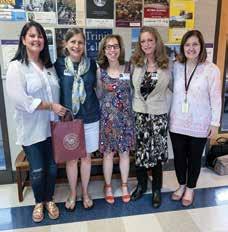
1974
MacRae Linton , Director of the Vanderbilt Lipid Clinic in the Division of Cardiovascular Medicine and the Atherosclerosis Research Unit, is part of a research team that received a $1 million grant from the W.M. Keck Foundation to explore atherosclerosis development.
1979
Susan Gleaves Bollig, Lynn Birdsong Hampton, Sarah Abram Chabon, and Debbie Kaplan Rosenwein spent an afternoon at USN visiting with Director of College Counseling Janet Carney Schneider and reminisced about the great memories they shared at PDS/USN.
1980
The Southern Illinoisan published an article on John Medwedeff, his background, and the metal sculptures he designed and built for Southern Illinois University.
1988
Tim Ozgener, Chief Executive Officer and CoFounder of Oz Arts, was featured in the October 18 edition of the Nashville Business Journal. The article reflects on the decision to continue on with OZ Arts after his father’s death last year. OZ Arts is a nonprofit performing and visual arts center born out of his father’s dream.
1994
West has been promoted to Associate Vice Chancellor for Federal Relations in Vanderbilt University’s Washington, D.C.-based Office of Federal Relations. West is responsible for managing the office and directing the university’s advocacy engagement at the federal level with members of Congress, administration officials, and federal regulatory departments.
Mallory Knox participated in the Skyline 50K Endurance Run in Oakland, California in August, and finished with a time of 5:38:46.

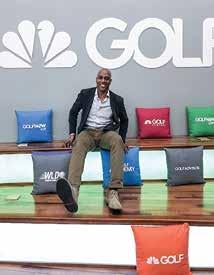

continued on page 43
2000 EDGEHILL
Christina
42
Far left to right: Kit Heard ’71, Paul Doster ’71, Lee Edwards ’71. Left to right: Barry Wilker ’71, Paul LeQuire ’71, Cathy Chitwood ’71, and Larry Dorris ’71.
Mallory Knox ’94
Brook Gardiner ’95
Barry Wilker ’71
Left to right: Lynn Birdsong Hampton ’79, Sarah Abram Chabon ’79, Debbie Kaplan Rosenwein ’79, Susan Gleaves Bollig ’79, and Janet Carney Schneider.
Jodie Adams Kirshner ’95
BeyondEdgehill Sarah Towle ’80
Sarah Towle joined USN as an eighth grader the year PDS became USN. Her experience put her on a career path to becoming an educator. She spent over 25 years in classrooms on four continents as a language and literacy educator. She now lives in London and is working on a novel of historical fiction and is launching a blog and podcast called “History Hero BLAST.”
Q: Why did you move abroad?
A: I’d been recruited out of my master’s program for a joint educational venture between Columbia University and Nanjing University. Two Columbia and two Nanjing professors formed a four-person department to create an intensive teacher-training program for Chinese in-service teachers of English. We were brought in to completely reshape the way English was being taught in China. Our institution became a small think-tank and nexus for English-language teaching in China. We trained at least one person from the English departments of each of China’s 60 “key” universities, boosting their language skills and teaching practice. And we did it all in English. It was 100% immersive. After a year with us, our trainees returned to their institutions ready to replicate the training they received in Nanjing, with our support. If you’ve ever wondered why the Chinese speak English so well today, it’s thanks to the College English Teacher Training Programme at Nanjing University.
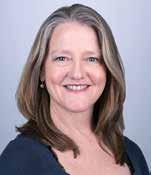
Q: What was it like being at USN?
A: I joined the school as an eighth grader in its first year as USN. Segregation had been outlawed for decades, but that didn’t mean other private school cultures were hospitable to African Americans and Jews. They were not. So USN attracted these families, making us a pretty equally representative school as far as race and religion go. We also enjoyed a different age and developmental stage on each of three floors. It was enriching to interact with kids both older and younger than you every day. We were never in a bubble at USN.
Many of our teachers were young. Some are still at the school today. They were dynamic, implementing the latest teaching theories and methodologies. We didn’t realize as kids what a forwardthinking education we were receiving. It was ahead of its time.
Q: You have lived abroad for many years. What have you been doing professionally?
A: I am an educator and author. I spent over 25 years in classrooms on four continents — North and South America, Asia, and Europe — as a language and literacy educator. In 2004, I relocated with my family to Paris and started writing full time. Organically, I found my way to writing for educational tourism. In 2010, I founded a small digital publishing company called Time Traveler Tours. We made interactive story-driven tours for museums and historic places.
Q: Tell me about your latest project.
A: I am now working on a novel of historical fiction set in Baltimore during the civil rights movement while keeping my passion for education alive with the History Hero BLAST blog and podcast. Our goal is to engage students with history, storytelling, and each other, by highlighting the figures, past and present that are most heroic and inspirational to them. Check out historyheroblast.com/educators and my Instagram @HistoryHeroBlast feed.
While I was a student at USN, the facilities were far less fancy. Everyone did art just to be in the studio at the far end of the parking lot. In fact, the arts were all strong in my memory. In addition to visual arts, we had a choir, there were bands. I remember a jazz band with a truly incredible drummer, and the theater kids always put on a great show.
What I loved most about USN, besides my friends, was that it was nestled within a major university. As USN students, we had access to Vanderbilt’s research facilities. That was thrilling to me. I spent many hours at the Joint Universities Library, pouring through books or ... wait for it ... reading microfiche.
Q: What is the most significant difference your USN experience is making or has made in your life today?
A: USN put me on the path to becoming an educator. I responded well to what would now be called the child-centered and inquiry-driven approach to education. I’ve done my best to replicate that in both my learning as well as my teaching environments since then. USN had a unique educational ethos, which I’ve carried with me throughout my career.
Q: What words of wisdom do you have for USN students today?
A: I would encourage them to beware of the lust for power and greed. Critical thinking, a belief in good science, and a willingness to embrace our neighbors — all neighbors — are what we need right now if we are to enjoy a healthy future on this planet. nn
UNIVERSITY SCHOOL OF NASHVILLE
usn.org/alumni n 43 UNIVERSITY SCHOOL OF NASHVILLE
1995
Brook Gardiner is the new Vice President of Labor Relations for NBCUniversal Media LLC and responsible for supporting NBCU’s owned-television stations and its NBCSports properties that cover Sunday Night Football, the Olympics, NASCAR, and golf. He also is a new member of USN’s National Alumni Board of Visitors.
Jodie Adams Kirshner discussed her new book, “Broke: Hardship and Resilience in a City of Broken Promises,” on NPR Morning Edition in November. She also hosted a book talk and signing at Parnassus Books on November 26.
1997
Faith Broughton McQuinn spoke on a panel about directing audio fiction at Podcast Movement in Orlando. Her production company Observer Pictures plans to release a limited series fiction podcast called “Margaritas & Donuts.” It’s a romantic comedy about dating over age 40. The company will also release the fourth and final season of “Boom,” its flagship fiction podcast, in February.
1999
Allison Fundis , Chief Operating Officer of Ocean Exploration Trust, led an expedition aboard EV Nautilus that found new clues to help solve the mystery of Amelia Earhart’s disappearance. The scientific expedition was funded by National Geographic and resulted in a two-hour special that aired in October.
2000
WSMV aired a feature on celebrity stylist and fashion designer Lacie Vincent Thorne returning to Nashville. She has worked with celebrities Jennifer Lopez, Adam Levine, and Nicki Minaj.

BeyondEdgehill
Joshua Kirshner ’92
Josh Kirshner, a Stanford Moore Award recipient and member of the 13 Year Club, graduated in 1992 and went to Harvard College. Six years ago he moved to the United Kingdom and works as an assistant professor at the University of York.

Leeman Tarpley Kessler ran unopposed for mayor of Gambier, Ohio and takes office in January.
2001
After 14 years as a high school English teacher, Ariel Neaderthal Voorhees left the classroom and entered the kitchen. As the founder of Gather Round Family Chef Service, she provides effortless weeknight dinners to busy families in the Washington, D.C. area. She also offers pack-the-freezer baby showers, hands-on cooking lessons, and meal planning services.
Q: What motivated you to move abroad?
A: I spent time abroad during my graduate studies, doing field research in various places. When I completed my Ph.D. in 2009, there were limited academic jobs in my field, so I took up a research fellowship at the University of Johannesburg in South Africa, then held a permanent position at another South African university and eventually took a position in the UK.
Q: What is your profession?
A: I am an assistant professor at the University of York in the Department of Environment and Geography. I work on interdisciplinary issues, including environmental governance, sustainable energy approaches, and urban community-led development.
Q: What do you love most about where you live?
A:The pubs, historic city centers and market towns, the countryside nearby which is pretty intact, without the large big-box construction one sometimes sees in the States. I value the close ties with Europe in academia here, although Brexit might make this more difficult.
Q: What was it like being at USN in the 1990s?
A: It seemed to be a transitional period for USN, moving away from the more free-spirited times of the 1970s and ’80s to a more structured approach.
Q: What is the most significant difference your USN experience has made in your life today?
A: The training I got in writing and critical thinking and in foreign languages and the arts. I am happy that I studied in the United States and at USN, specifically. nn
2000 EDGEHILL
44 n usn.org/alumni
2000 EDGEHILL
Ariel Neaderthal Voorhees ’01
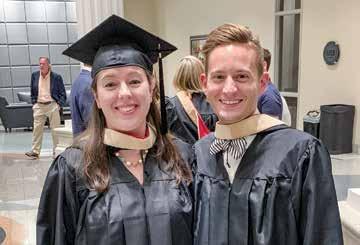

The Aspen Institute announced Max Goldberg is one of 21 honorees for the 2019 Class of Henry Crown Fellows. The fellowship brings together leaders to “tackle the world’s most intractable problems.”
Medical oncologist Stephen Schleicher coauthored a study in the Journal of American Medical Association on the challenges of incorporating novel oncology drugs into an oncology value-based care model.

2003
The Tennessean published an opinion editorial by scooter enthusiast Steven Venick titled “Don’t give up on Nashville’s scooter experiment yet. It could still work.”
2004
Hannah Moots , a graduate student in anthropology and co-lead author of an international research team from Stanford University, the University of Vienna, and Sapienza University of Rome, is researching the first genetic history of Rome. ScienceDaily published an article about the research.
2005
Kathryn Berk won a Daytime Emmy Award for an opioid awareness documentary she produced called “Rebekah’s Story.” Pictured with the Emmy is her puppy Finn.
Zach Wexler earned his Master of Business Administration in Healthcare from Belmont University.
2006
The New York Times reviewed author W. M. “Will” Akers’s debut novel, “Westside,” and described it as “a literary cocktail of gun molls, rotgut moonshine and skittering shadows.” “His prose is sharply crystalline, especially when describing minute, bittersweet and even ugly moments.”
Page Krugman received her Master of Business Administration from Belmont University.
David Patton has transitioned to living as Naomi Patton. She is thankful for all the community and family support she has received in this process. She also became a homeowner and works in education research at the University of Maryland.
2007
Calle Nielson has been named the new head coach of University of Richmond’s women’s golf team.
The Lakeview Chamber of Commerce in Illinois named Dillon Goodson as its new Executive Director. He is responsible for providing vision, direction, and leadership to the Lakeview Chamber as well as its partners.
TJ Ducklo, former Vice President Joe Biden’s National Press Secretary, returned to USN in November to speak to students and faculty about his new role.
2011
Mara Steine is working in Chicago for the American Jewish Committee as an Advancement and Engagement Associate.
continued on next page
UNIVERSITY SCHOOL OF NASHVILLE 45
usn.org/alumni n
Zach Wexler ’05 and Page Krugman ’06 were in the same MBA graduating class.
Director Vince Durnan interviews TJ Ducklo ’07 about his career.
The Emmy Award and dog of Kathryn Berk ’05
n usn.org/alumni
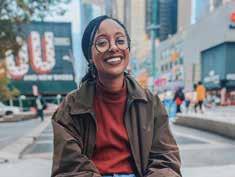

2014
Case Nieboer is living in South Dakota and working for Teach for America.
2015
Simpson Tanner graduated from Dartmouth College and spent the summer in Creede, Colorado working on a fly fishing ranch. He stayed busy with his ranch hand duties and also spent time fishing, backpacking, camping out, off roading and mountain biking. He now works for Junior Golf Tour of Asia.

Ashtan Towles joined the Mayor’s Office of Criminal Justice in New York City. She started her work as a Program Analyst at the Mayor’s Office for the Prevention of Hate Crimes. The intention is for the office to work with various agencies on strategies to combat anti-Semitic and anti-immigrant hate crimes, as there is currently no clear coordination between the New York Police Department and the Department of Education for responding to hate crime incidents. Another role for the new office is to come up with initiatives to teach tolerance to New Yorkers of all ages.

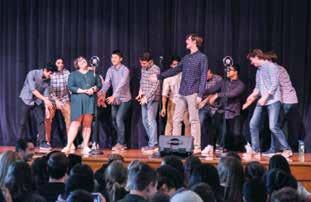
Sarah Wingo joined USN as the High School Debate Assistant and is helping with out of town trips.
Douglas Corzine returned to USN with the Princeton Footnotes to sing during High School’s Assembly in October. He is president of the all-male a cappella group, which even serenaded English Teacher Freya Sachs ’00.
Evan Wilkerson joined USN Technical Theater Director Jim Manning to design the set for the Nashville Shakespeare Festival, directed by his dad, David Wilkerson. The Class of 2022 plans to see the production at Belmont University’s Troutt Theater in January.
2016
The Jamaica Lacrosse Association selected Kara-Jade Gordon for the National Women’s Lacrosse team. She competed in the Pan American Lacrosse Association World Championship qualifiers in November in Auburndale, FL.
Madigan Wheelock traveled to Copenhagen this summer to study politics through a Scandinavian study abroad program through Wake Forest University where she is a senior.
Aidan Rowan ‘16 joined several other alumni to intern in U.S. Rep Jim Cooper’s Nashville office during the summer.
2017
Duncan Clark visited USN in November to talk with students about his experiences in the United States Coast Guard Academy.
During the summer, Elsa Wilson and Brian Davis Jr. interned in U.S. Rep Jim Cooper’s Washington. D.C. and Nashville offices, respectively.
2018
Kensi Juszkiewicz is studying abroad in Siena, Italy.
Sam Strang provided his disc jockey services for USN’s annual Popsicle Party. Sam is founder of DJ Non-Profit and shares his love of music by offering his services for free to nonprofit organizations.
Drew Dibble made the roster for the Davidson Wildcats men’s basketball team. His fan club of USN faculty and friends attended his game versus Vanderbilt University on December 30.
2000 EDGEHILL 46
Kensi Juszkiewicz ’18
Sam Strang ’18
Ashton Towles ’15
Douglas Corzine ’15
Simpson Tanner ’15
Jackson Joffe joined several other alumni to intern in U.S. Rep Jim Cooper’s Nashville office during the summer.
2019
An article by Haley Harris was published in the September edition of ServeInDeed, The Tennessee Journal of Service-Learning & Community Engagement. Haley reflects on and outlines a workshop she and seven other USN students led at a leadership seminar at the Tennessee Volunteer Conference.
WEDDINGS
Kenneth Burns ‘89 wed Ereck Jarvis on August 4, 2019, at the Viva Las Vegas Wedding Chapel in Las Vegas. They live in Natchitoches, Louisiana, and work at Northwestern State University, where Ereck is an English professor and Kenneth advises the student newspaper, yearbook, and radio station.
Julie Eskind ’02 wed Andrew Galbierz in Nashville on June 22, 2019 at the Country Music Hall of Fame.
Abby Michaud ’02 wed Charlie Arnold on August 3, 2019 in County Clare, Ireland at Dromoland Castle. Friends from the Class of 2002 in attendance were Ashley Farmer, Allison Cate Murray, and Beth Petrey Finch.
Eleanor Schneider ’05 wed Russell Ries ’02 on July 11, 2019 in Dorking, Surrey, England. Friends from the Class of 2005 in attendance were Katherine “Kaki” Campbell , Eleanor Schneider, Rachel Bubis , and Catherine Berk
Isabel Ross ’06 wed William Dale on May 11, 2019 at Ruby Nashville. Isabel’s sister, Michelle Ross Stephens ’00 was her maid of honor. Friends from the Class of 2006 in attendance were Audrey Richardson Wrenn, Tessa Lamballe Stewart, Carly Compas Horn, Erin Shmerling Brock, and Molly Cunningham Snow.
Ethan Dubois ’08 wed Lauren Pellicci on June 29, 2019, and they are parents of puppy Huck.

BIRTHS
Suzanne Foy McNulty ’00 and Patrick McNulty welcomed Caroline Connolly McNulty on May 30, 2019.
Kate and Dan Chazin ’04 welcomed Regan Tygielski Chazin on July 31, 2019.
Carrie Spitz Purser ’04 and Dave Purser welcomed Bennett Steele Purser on September 3, 2019.
Stephanie Hecklin Soskin ’04 and Jorie Soskin welcomed Riley Shea Soskin on February 14, 2019.
Allison Duke Budslick ’05 and Paul Budslick welcomed Mary Elizabeth “Bea” Budslick on July 4, 2019.
Katie Goldstein Jarrett ’05 and Ben Jarrett welcomed Charles “Charlie” Seligman Jarrett on October 9, 2019.
Hillary Price ’06 and Jared Daiber welcomed Thomas Hill Daiber-Price on August 22, 2018.
Mariel Snetman Linton ’08 and Sam Linton ’08 welcomed Margot Louise Linton on June 26, 2019.
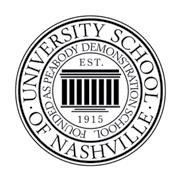

UNIVERSITY SCHOOL OF NASHVILLE 47
usn.org/alumni n University School of Nashville usn.org f @USN.PDS i University School of Nashville l @USN_PDS @USN_PDS To keep up with PDS/USN news between biannual issues of 2000 Edgehill, follow us on social media. #beyondEdgehill
Weddings



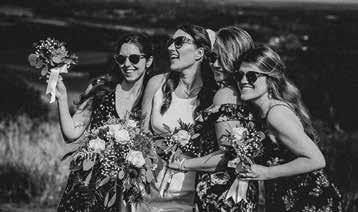



2000 EDGEHILL
48
Julie Eskind ’02 wed Andrew Galbierz
In attendance at the wedding of Abby Michaud ’02 and Charlie Arnold were her classmates Ashley Farmer, Allison Cate Murray, and Beth Petrey Finch.
Eleanor Schneider ’05 with classmates Katherine “Kaki” Campbell, Rachel Bubis, and Catherine Berk.
In attendance at the wedding of Isabella Ross ’06 and William Dale were her classmates Audrey Richardson Wrenn, Tessa Lamballe Stewart, Carly Compas Horn, Erin Shmerling Brock, and Molly Cunningham Snow.
Ethan Dubois ’08 wed Lauren Pellicci

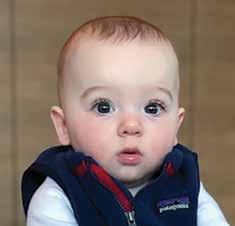

Births





UNIVERSITY SCHOOL OF NASHVILLE
Bea, daughter of Allison Duke Budslick ’05
Regan, daughter of Dan Chazin ’04
Caroline, daughter of Suzanne Foy McNulty ’00
Charlie, son of Katie Goldstein Jarrett ’05
Thomas, son of Hillary Price ’06
Margot, daughter of Mariel Snetman Linton ’08 and Sam Linton ’08
Riley, daughter of Stephanie Hecklin Soskin ’04
49
Bennett, daughter of Carrie Spitz Purser ’04
In Memoriam

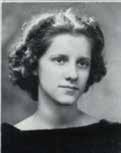




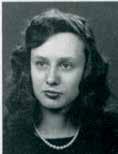
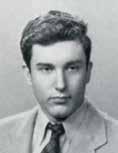



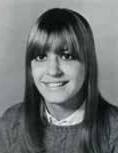
We remember these deceasedalumni, former students, and faculty for their contributions to PDS/USN and beyond Edgehill. Included on this page are those of whose deaths we have recently learned, even when some years have passed. To read their obituaries, visit usn.org/publications .






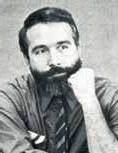


50 2000 EDGEHILL
Adair Tune Schippers ’59 August 31, 2019
Thomas Woodard ’51 June 26, 2019
Frank Grantham ’67 November 21, 2019
Marilou Gardner Sanders ’41 December 12, 2018
Lucy Garrison Crabb ’38 July 5, 2019
Anne Kate Dury Womack ’36 October 6, 2019
Dorothy Elliot Pettit ’48 March 3, 2019
Mary Durstine McArtor Reynolds French Teacher 1989-1991 January 7, 2020
Thomas Herbert “Tom” Nixon ’61 Spring 2019
Robert Massie III ’46 December 2, 2019
Hugh Smith ’70 July 27, 2018
Craig Burr ’79 August 21, 2019
John Colozzi American & Russian History Teacher May 4, 2019
Gertrude Nixon ’69 December 29, 2019
Thomas Lyle Greer ’64 September 5, 2017
Richard Henry “Dick” Johnson ’66 December 12, 2019
Stephen Cragon ’46 December 14, 2019
Everett Kelley ’46 December 31, 2019
John Nixon ’51 December 19, 2019
Jean Gray Litterer Interim Director 1999-2000 January 22, 2020
usn.org/alumni
Linda Reese ‘70 May 6, 2011
n
Tiger Give Back Challenge
Join the PDS/USN community in supporting the Tiger Give Back Challenge on March 26, 2020. This annual event to garner participation in the Annual Fund will begin with a Kick-Off Party for Nashville families and alumni from 5:30 to 7:30 p.m.
March 25, 2020 at Fat Bottom Brewery.
The following day, USN Tigers of all ages and even those living beyond Edgehill will come together for 24 hours to support USN students, faculty, staff, and programs through gifts to the Annual Fund. The Annual Fund supports the school’s highest priorities for the year, faculty professional development, need-based financial aid, academic programming, visual & performing arts, athletics & lifelong wellness, and campus & environmental stewardship. The 2019-2020 Annual Fund goal is $1.65 million and will contribute 6% of USN’s operating budget.
The goal of the Tiger Give Back Challenge is to raise more than $150,000 from over 800 donors. Participation is key. Each grade level is seeking the greatest amount of participation from its families.
Back for the second year is the Alumni March Madness Bracket. In four rounds, PDS/USN alumni all over the world will rally to support their alma mater. The regions with the highest participation percentage — calculated by the total number of gifts given and total number of eligible donors — will advance. The winning area is awarded a special alumni event with Director Vince Durnan and its victory will be displayed on campus and in school publications. Will Illinois reign as the champion of Tiger pride again?


For more information and to give, visit usn.org/tigergiveback. Gifts are welcome year-round at usn.org/giving.
the classes of 1970, 1975, 1980, 1985, 1990, 1995, 2000, 2005, 2010, 2015, and
6 6
z z z z z PDS USN 2020 MAKE PLANS TO JOIN US APRIL 30-MAY 2
for more information, visit usn.org/reunion
REUNION
celebrating
all gold circle classes



















































 By Kelicia Cox, Assistant Head of Middle School
By Kelicia Cox, Assistant Head of Middle School

































































































